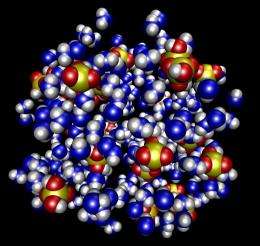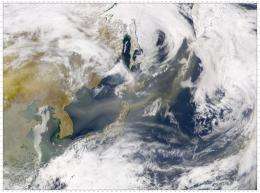Tiny particles, big impact

Atmospheric aerosols may be small, ranging in size from a few nanometers to a few microns, but they have a big impact on climate. At the Pacific Northwest National Laboratory, capabilities developed through the Laboratory Directed Research and Development program are delivering new insights into the formation, aging and transport of aerosol particles, whether they are created by nature or human activity. Two computational advances: the Aerosol Modeling Testbed and a computational approach, known as the particle resolved model, are bringing into sharper focus the effects of aerosols on climate change.
Much of the uncertainty in climate change projections comes from the complex interactions of clouds and aerosols, and the difficulty of incorporating this information into climate models. These tiny particles serve as the "seeds" of cloud droplets and ice crystals, which make up the clouds that cool or warm the earth. Aerosols also influence climate by absorbing and reflecting sunlight.
Human activity has increased aerosols' influence on climate since the late 1800s, but their effect is uncertain because the connections between human activity and climate are complex and not well understood. The improved ability to quantify aerosol effects is leading to more accurate climate models and better projections of climate change.
PartMC-MOSAIC—Aerosols are a complex pastiche of soluble salts, dust, soot, and organic compounds that change chemically and physically as they interact and age in the atmosphere. The newly developed particle-resolved aerosol model - PartMC-MOSAIC - provides an accurate way of numerically depicting aerosol particles as they age. While it is too computationally intense to be used in a full-blown climate model, PartMC-MOSAIC serves as a benchmark tool for climate modelers to use. PartMC-MOSAIC allows, for the first time, accurate detailed simulations of the aging of complex externally mixed aerosols due to coagulation and condensation of semi-volatile gases.

PartMC-MOSAIC was recently applied to an idealized plume of Los Angeles aerosol emissions. It simulated the evolution and mixing of particles ranging from engine exhaust to cooking meats as well as how these particles would absorb of reflect sunlight and how they would serve as the nuclei of cloud droplets.
Aerosol Modeling Testbed—The Testbed provides a computational framework to systematically and objectively evaluate the performance of aerosol process modules, which are elements within larger climate models that calculate specific climate conditions. The Testbed consists of the WRF-Chem model that simulates meteorology, chemistry, and aerosols interactively, a series of testbed cases, and a suite of tools called the Analysis Toolkit. The Analysis Toolkit documents the evaluation of researcher's aerosol process modules.
First, the researcher's aerosol process module is run using WRF-Chem and configuration files set up for a testbed case. Results are saved in an archive that also contains the control simulation. The control serves as the benchmark for all comparisons.
Next, the toolkit extracts the output for the aerosol module. By comparing the results with the control simulation, the researcher can appraise the performance of the aerosol module. If needed the aerosol module can be run with the other testbed cases. In this way, the Testbed quantifies incremental changes in the performance of the aerosol module while all other atmospheric processes remain the same.
Many of the capabilities developed in this PNNL LDRD program are being applied to interpret and evaluate comprehensive field observations of different types of aerosols and their effects on climate. The treatment of aerosol processes in the Community Earth System Model has been applied to the Aerosol Modeling Testbed and is being evaluated using measurements from field experiments in Mexico and Barrow Alaska (see sidebar).
More information: Fast JD, et al. 2009. "Applying the Aerosol Modeling Testbed to Assess Modal and Sectional Predictions of Particulates and Aerosol Radiative Forcing Downwind of a Megacity." Presented at the 11th Conference on Atmospheric Chemistry, 89th American Meteorological Society Annual Meeting, January 10-16, 2009, Phoenix, AZ.
Fast JD, et al. 2011. "The Aerosol Modeling Testbed: A Community Tool to Objectively Evaluate Aerosol Process Modules." Bulletin of the American Meteorological Society, 92, 343-360. DOI: 10.1175/2010BAMS2868.1
Riemer N, et al. 2010. "Estimating Black Carbon Aging Time-Scales with a Particle-Resolved Aerosol Model." Journal of Aerosol Science 41(1):143-158. DOI:10.1016/j.jaerosci.2009.08.009.
Riemer, N, et al. 2009. "Simulating the evolution of soot mixing state with a particle-resolved aerosol model." Journal of Geophysical Research, 114, D09202. DOI:10.1029/2008JD011073.
Zaveri, RA, et al. 2010. "Particle-resolved simulation of aerosol size, composition, mixing state, and the associated optical and cloud condensation nuclei activation properties in an evolving urban plume." Journal of Geophysical Research, 115, D17210. DOI:10.1029/2009JD013616.
Provided by Pacific Northwest National Laboratory


















